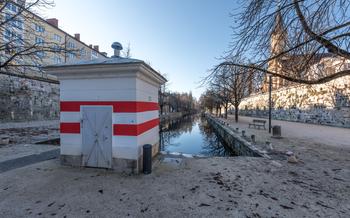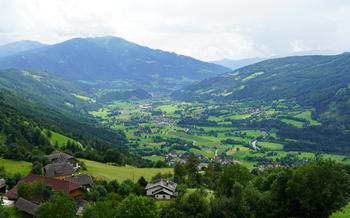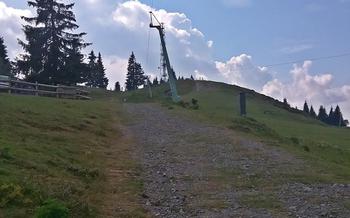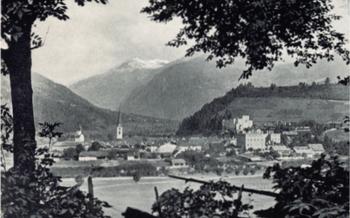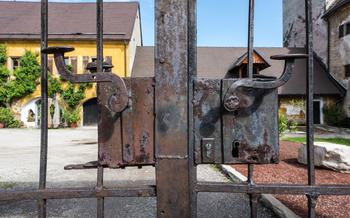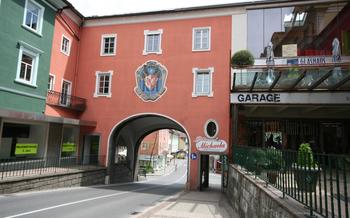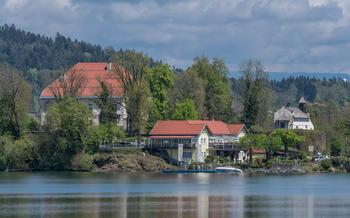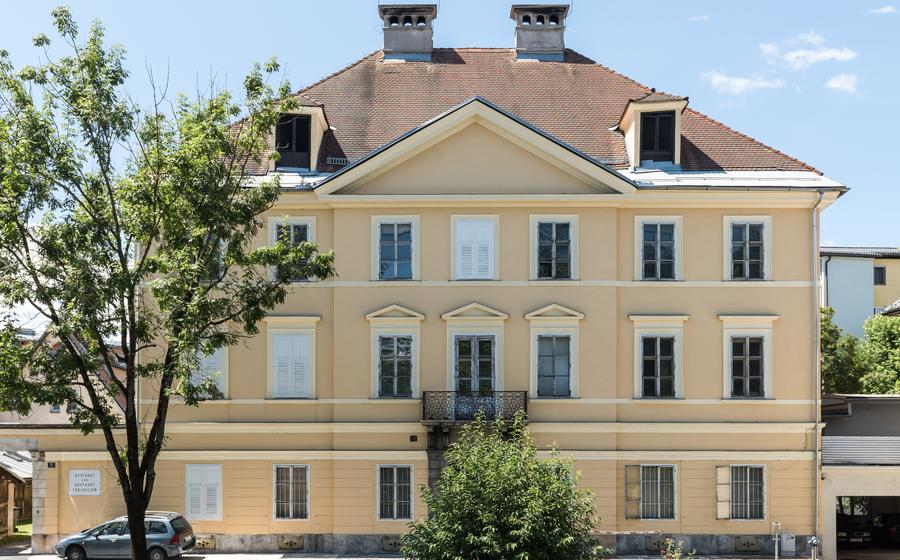
Hiking in the Karawanken Mountains (nearby)
- The Karawanken Mountains: A Tapestry of Nature and History
- Hiking Routes
- Picturesque Viewpoints
- Alpine Lakes and Rivers
- Mountain Huts and Refuges
- Flora and Fauna:
- Geology and Geomorphology
- Cultural Heritage
- Hiking Season and Weather Conditions
- Guided Tours and Hiking Clubs
- Maps and Navigation
- Packing Tips and Essential Gear
- Leave No Trace Principles
The Karawanken Mountains: A Tapestry of Nature and History
Nestled along the southern border of Austria, the Karawanken Mountains stand as a testament to the power of nature's artistry. Formed millions of years ago by the collision of the African and Eurasian tectonic plates, these mountains unveil a rich tapestry of history, geology, and breathtaking landscapes.
The Karawanken Mountains, stretching over 120 kilometers, form a natural border between Austria and Slovenia. Their peaks, reaching towards the heavens, offer panoramic vistas that stretch for miles. The region's history is intertwined with the mountains, as ancient trade routes traversed these passes, connecting cultures and economies.
Geologically, the Karawanken Mountains are a treasure trove of wonders. The forces that shaped them have left behind a landscape adorned with towering peaks, deep gorges, and pristine lakes. The mountains' composition, a blend of limestone, dolomite, and slate, has resulted in a fascinating array of rock formations, caves, and fossils.
The Karawanken Mountains are also a haven for biodiversity. Alpine meadows burst with a kaleidoscope of wildflowers, while forests of spruce, fir, and beech trees provide shelter for a diverse array of wildlife. Marmots, chamois, and birds of prey are just a few of the creatures that call these mountains home.
Recognizing the ecological significance of the Karawanken Mountains, conservation efforts are underway to protect this natural paradise. Sustainable tourism initiatives aim to strike a balance between preserving the environment and allowing visitors to experience its beauty responsibly.
To fully immerse yourself in the wonders of the Karawanken Mountains, Klagenfurt am Wörthersee serves as an ideal base camp. From this charming city, a gateway to the mountains, hikers can embark on unforgettable journeys, exploring the trails that wind through this magnificent natural wonder.
Hiking Routes
The Karawanken Mountains offer a diverse range of hiking trails suitable for all levels of experience. Whether you are a seasoned hiker seeking a challenging climb or a family looking for a leisurely stroll, you will find trails that cater to your preferences.
Popular Trails for Beginners and Families:
-
Lake Faaker Loop: This 2-hour loop trail around Lake Faaker is perfect for beginners and families with young children. The trail is mostly flat and offers stunning views of the lake and the surrounding mountains.
-
Mittagskogel Trail: This moderate 3-hour trail leads to the summit of Mittagskogel, one of the most popular peaks in the Karawanken Mountains. The trail offers panoramic views of the surrounding landscape and is a great option for families with older children.
Trails for Experienced Hikers:
-
Hochstuhl Trail: This challenging 6-hour trail leads to the summit of Hochstuhl, the highest peak in the Karawanken Mountains. The trail is steep and rocky in sections, but the breathtaking views from the summit make it worth the effort.
-
Karawanken High Trail: This long-distance trail runs for 100 kilometers along the entire length of the Karawanken Mountains. The trail is divided into several stages, each of which can be completed in a single day. The Karawanken High Trail is a great option for experienced hikers looking for a multi-day adventure.
Tips for Hiking in the Karawanken Mountains:
-
Plan your route in advance: Use maps and guidebooks to choose trails that are appropriate for your fitness level and experience.
-
Be prepared for all weather conditions: The weather in the mountains can change quickly, so be sure to pack layers of clothing and rain gear.
-
Bring plenty of water and snacks: There are no water sources along most trails, so be sure to bring enough water and snacks to stay hydrated and energized.
-
Stay on marked trails: It is important to stay on marked trails to avoid getting lost and damaging the environment.
-
Respect wildlife: The Karawanken Mountains are home to a variety of wildlife, so be sure to respect their habitat and keep your distance.
Picturesque Viewpoints
Along the hiking trails of the Karawanken Mountains, hikers are rewarded with breathtaking viewpoints that offer panoramic vistas of the surrounding landscape. The panoramic views from the summits of the mountains are simply breathtaking, with rolling hills, lush forests, and shimmering lakes stretching as far as the eye can see.
One of the most popular viewpoints is the Klagenfurt Viewing Platform, which offers a bird's-eye view of the city and the Wörthersee lake. Another must-visit spot is the Pyramidenkogel Tower, a 100-meter-high observation tower that provides stunning 360-degree views of the Karawanken Mountains and the surrounding countryside.
For those seeking a more secluded experience, there are several lesser-known viewpoints that offer equally impressive panoramas. The Hochstuhl Mountain, for example, offers a stunning view of the Mittagskogel, the highest peak in the Karawanken Mountains. The lookout point at the summit of the Petzen Mountain, on the other hand, provides a breathtaking view of the Drava Valley and the Karawanken ridge.
To make the most of your hiking experience, plan your hike to catch the sunrise or sunset at one of these scenic viewpoints. The golden hues of the rising or setting sun cast a magical glow on the landscape, creating a truly unforgettable experience.
Alpine Lakes and Rivers
The Karawanken Mountains are home to pristine lakes and rivers that offer a refreshing respite after a day of hiking. Lake Wörthersee, the largest lake in the region, is renowned for its crystal-clear waters and stunning turquoise hue. Swimmers, kayakers, and paddleboarders can take advantage of the lake's calm waters and picturesque surroundings.
For a more secluded experience, Lake Faaker See, with its emerald-green waters, offers a tranquil setting for swimming and sunbathing. Anglers will delight in the opportunity to fish for trout in the crystal-clear rivers that cascade down the mountain slopes.
Pack a picnic lunch and find a scenic spot along the lakeshore to enjoy a leisurely meal with breathtaking views. Remember to practice responsible tourism by respecting the delicate ecosystems of these water bodies and leaving no trace of your visit.
Mountain Huts and Refuges
In the Karawanken Mountains, hikers will find a network of mountain huts and refuges that offer shelter, food, and emergency lodging. These huts are typically located along popular hiking trails and provide a welcome respite for weary hikers. Some of the most popular huts include the Klagenfurter Hütte, the Eisenkappler Hütte, and the Petzenhaus. These huts offer basic amenities such as dormitory-style sleeping quarters, dining areas, and restrooms. They also provide meals, snacks, and beverages for purchase.
For those planning to embark on multi-day hikes or seeking a more immersive mountain experience, staying overnight in a mountain hut is a great option. Reservations are recommended, especially during peak season, to secure a spot in the cozy dormitories. The huts also serve as a base for exploring the surrounding mountains, with many offering guided hikes and other activities.
Beyond their practical function, these mountain huts hold historical and cultural significance. Many of them have been in operation for over a century, serving as a refuge for generations of hikers and mountaineers. They are often staffed by experienced mountain guides who can provide valuable advice and assistance to hikers.
When planning your hiking trip in the Karawanken Mountains, be sure to consider incorporating a stay in one of the mountain huts. It's an excellent way to immerse yourself in the region's mountain culture, enjoy the stunning scenery, and make memories that will last a lifetime.
Flora and Fauna:
The Karawanken Mountains boast an incredibly rich biodiversity, with a wide array of plant and animal species thriving in its diverse ecosystems. Alpine meadows burst into bloom during the summer months, adorned with a vibrant tapestry of wildflowers, including gentians, edelweiss, and anemones. These colorful displays attract a variety of pollinators, such as butterflies and bees, adding to the vibrancy of the mountain scenery.
Among the wildlife that call these mountains home, marmots are a common sight, often spotted sunbathing on rocky outcrops or foraging for food. Chamois, with their agile movements and sure-footedness, can be seen grazing on steep slopes, while birds of prey, such as eagles and hawks, soar overhead, searching for their next meal. The Karawanken Mountains also provide a habitat for a variety of reptiles, amphibians, and invertebrates, contributing to the region's overall biodiversity.
Conservation efforts are paramount in protecting the delicate ecosystems of the Karawanken Mountains. Strict regulations are in place to minimize human impact and preserve the natural beauty of the region. Visitors are encouraged to follow Leave No Trace principles, respecting wildlife habitats and minimizing their ecological footprint. By working together, we can ensure that future generations can continue to enjoy the breathtaking landscapes and rich biodiversity of these majestic mountains.
Geology and Geomorphology
The Karawanken Mountains boast a captivating geological history that has shaped their unique landscape. Over millions of years, tectonic forces and glacial movements have sculpted these mountains, creating a fascinating array of rock formations, caves, gorges, and other geological wonders. The region's karst topography, characterized by dissolvable limestone, has resulted in the formation of enchanting caves and underground rivers, inviting explorers to delve into the subterranean secrets of the mountains.
Hikers can marvel at the towering peaks, formed from sedimentary and metamorphic rocks, which tell the story of ancient seabeds and continental collisions. The Karawanken Mountains are also home to a variety of caves, including the world-famous Obir Caves, which offer a subterranean adventure through a labyrinth of chambers adorned with stalactites and stalagmites.
The impact of glacial activity is evident throughout the region, with moraines and cirques shaping the landscape. These remnants of past glaciers have created picturesque valleys, serene alpine lakes, and cascading waterfalls, adding to the scenic beauty of the Karawanken Mountains.
Cultural Heritage
The Karawanken Mountains region is steeped in history and cultural traditions. Alpine villages and towns nestled within the mountains have preserved their unique customs, festivals, and folklore. The region's rich heritage is showcased through traditional music, dances, and handicrafts. Visitors can witness the vibrant Alpine lifestyle firsthand by attending local festivals and events.
Historical sites and landmarks, such as medieval castles, ancient churches, and fortifications, dot the landscape, offering a glimpse into the region's past. Explore the ruins of Hochosterwitz Castle, perched atop a rocky hill, or visit the historic town of Völkermarkt, with its well-preserved medieval center. These sites tell the stories of the region's rich history, from Celtic settlements to Roman rule and the Middle Ages.
Local crafts, such as wood carving, pottery, and textile weaving, have been passed down through generations and are still practiced in the region. Visitors can purchase handmade souvenirs and support local artisans by visiting craft markets and workshops. The cuisine of the Karawanken Mountains region is also a reflection of its cultural heritage, with hearty dishes like Käsespätzle (cheese dumplings) and Schlutzkrapfen (filled pasta) showcasing the region's culinary delights.
Hiking Season and Weather Conditions
The best time to visit the Karawanken Mountains for hiking is from June to October. During this period, the weather is generally mild and stable, with warm days and cool nights. However, it's important to be prepared for unpredictable mountain weather, as conditions can change rapidly.
Spring and autumn can also be beautiful seasons for hiking, as the landscapes transition with vibrant colors. However, be prepared for cooler temperatures and potential rain or snow.
Winter hiking is possible, but it requires special equipment and experience due to snow and ice. It's essential to check trail conditions and avalanche risks before venturing out in winter.
Always pack layers of clothing, including a waterproof jacket and warm fleece, as temperatures can drop significantly at higher altitudes. Sturdy hiking boots with good ankle support are a must, and don't forget essentials like a hat, sunglasses, and sunscreen to protect yourself from the sun's rays.
Before your hike, check the weather forecast and plan accordingly. Be prepared to turn back if the weather deteriorates or if you encounter hazardous conditions.
By being well-prepared and respecting the mountain environment, you can have a safe and enjoyable hiking experience in the Karawanken Mountains throughout the year.
Guided Tours and Hiking Clubs
Hiking in the Karawanken Mountains can be an even more enriching experience when you join a guided tour or become part of a local hiking club. Guided tours offer several advantages, including safety, information, and companionship. Experienced guides lead the way, ensuring you stay on the right path, avoid potential hazards, and learn about the region's history, flora, and fauna.
Numerous local hiking clubs and organizations in the area organize guided hikes and social events throughout the year. Joining a hiking club is a fantastic way to meet like-minded individuals, enhance your hiking skills, and share unforgettable experiences. Clubs often organize group hikes of varying difficulty levels, catering to different fitness levels and interests.
The benefits of joining a hiking club extend beyond shared experiences. Clubs often provide training and skill development opportunities, such as navigation workshops, first-aid courses, and winter hiking techniques. Members can also participate in social events, such as potlucks, film screenings, and talks by guest speakers.
Finding a reputable hiking tour operator or club is essential for a safe and enjoyable experience. Look for companies or clubs with a good reputation, experienced guides, and a commitment to safety and sustainability. Reading online reviews, asking for recommendations from local tourism offices or hotels, and checking for certifications or affiliations with reputable organizations can help you make an informed choice.
Maps and Navigation
Hiking in the Karawanken Mountains requires careful navigation, especially in unfamiliar terrain. Detailed maps and reliable navigation tools are essential for staying on track and ensuring a safe journey.
Recommended Maps:
- Purchase high-quality topographic maps of the Karawanken Mountains region.
- Look for maps with a scale of 1:25,000 or 1:50,000 for detailed trail information.
- Consider purchasing a set of maps covering the entire region or specific areas you plan to explore.
Navigation Apps:
- Download offline navigation apps like Maps.me or OsmAnd for smartphone or GPS devices.
- These apps allow you to track your progress, view topographic maps, and navigate without an internet connection.
- Make sure to download the relevant maps for the Karawanken Mountains region before your trip.
Reading Topographic Maps:
- Familiarize yourself with topographic map symbols and conventions before your hike.
- Learn to interpret contour lines, elevation markers, and other map features.
- Practice reading maps and identifying landmarks to develop your navigational skills.
Using a Compass:
- Carry a compass and know how to use it for orientation.
- Calibrate your compass before each use and keep it away from metal objects that can interfere with its accuracy.
- Use the compass to determine your direction of travel and align it with the map to stay on track.
Safety Precautions:
- Always carry a map and compass, even on familiar trails.
- Inform someone about your hiking plans, including your route and expected return time.
- Be prepared for unexpected weather changes and carry a whistle, flashlight, and emergency blanket.
- If you get lost, stay calm and retrace your steps. If necessary, call for help or seek assistance from other hikers.
Packing Tips and Essential Gear
When embarking on a hiking adventure in the Karawanken Mountains, it's crucial to be well-prepared with the right gear. For a day hike, a comfortable backpack is essential for carrying essentials like food, water, and a first-aid kit. Choose sturdy hiking boots or shoes that provide good ankle support and traction on uneven terrain.
Pack layers of clothing to adapt to changing weather conditions, including a waterproof jacket and pants in case of rain. A hat, sunglasses, and sunscreen are vital for sun protection. Don't forget a pair of trekking poles for added stability and to reduce strain on your knees.
For overnight trips, pack a lightweight tent, sleeping bag, and sleeping pad for a comfortable night's rest. A stove and cooking utensils will allow you to prepare meals. A headlamp or flashlight is crucial for navigating in the dark.
Remember to pack a first-aid kit with basic medical supplies, a whistle for emergencies, and an emergency blanket for warmth. A map and compass or a reliable navigation app are essential for staying on track.
Optional items like binoculars can enhance your wildlife spotting experience, and a camera will help you capture the stunning scenery. Consider bringing along a power bank to keep your electronic devices charged.
By packing the right gear and being prepared for any situation, you can fully embrace the beauty and challenges of hiking in the Karawanken Mountains.
Leave No Trace Principles
Practicing Leave No Trace principles is essential for preserving the pristine beauty of the Karawanken Mountains. This ethical code guides hikers to minimize their impact on the environment and respect wildlife.
First and foremost, proper waste disposal is crucial. Always carry a small bag to collect trash, including food scraps and packaging. Avoid leaving anything behind, even biodegradable items like fruit peels, as they can still harm wildlife.
When it comes to campfires, choose designated fire pits or build your own in a safe location, away from vegetation. Use deadwood for fuel and never leave a fire unattended. Extinguish it completely before leaving the campsite.
Respecting wildlife is paramount. Observe animals from a distance and avoid disturbing their natural behavior. Never feed them, as it can disrupt their feeding habits and make them dependent on humans.
To hike responsibly, stay on marked trails to prevent erosion and damage to vegetation. Avoid shortcuts and don't create new trails. Respect plant life by not picking flowers or damaging trees.
Leave No Trace principles are not just rules but a mindset that fosters a deep appreciation for the natural world. By following these guidelines, hikers can help protect the Karawanken Mountains for future generations to enjoy.
